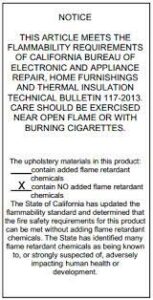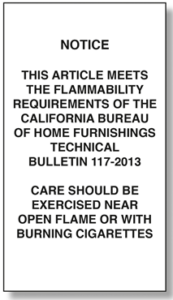CEH Tools to Help You Choose Healthier Furniture
Procurement and Business Tools
How to Work With Your Supply Chain
Purchasing new furniture is a major spend category for institutions. Purchasing furniture without the “Hazardous Handful” is an effective way to improve the health of your indoor office environment and prevent these chemicals from migrating into and polluting outdoor environments. The Center for Environmental Health can help you achieve your healthier furnishings goals every step along the way. Here are resources that will support your business or organization to get the furniture you want without chemicals of concern.
Share your goals and expectations for healthier furniture with your suppliers
- Send a letter: You can use this model letter to vendors to alert your suppliers of your desire to procure furniture without chemicals of concern. This type of market signaling can motivate companies to make the transition to safer products more quickly.
- Have a conversation: Numerous institutions who have made the switch to purchasing healthier furniture have initiated the transition by hosting a conversation with their top furniture suppliers. By directly communicating the organization’s intentions, and having a dialogue with suppliers, compliance with your new health protective standards and successful implementation are more likely.
Conduct a Furniture Survey
- Survey your institution’s existing or potential furniture suppliers to identify environmentally preferable products. It is important to identify which of their product lines, furniture configurations within product lines, fabrics and accessories are free of the Hazardous Handful. This can be accomplished by referring to CEH’s Database of Healthier Furniture. If the product is not listed on our database, ask suppliers for proof of compliance, for example, by using one of the certification programs in our Learning Tools section.
Build in Requirements/Preferences for Healthier Products During Bid or Contract Phase
- To ensure that healthier options are identified, ask manufacturers to identify preferable products that can meet your new specifications either as part of a Request for Proposals (RFP) or Request for Information (RFI).
- To ensure compliance with the specifications, request that all products be certified to one of the three certification programs we describe in the Learning Tools Section. If an insufficient number of products are currently certified, you can build in a 12-18 month “grace period” during which the manufacturers must achieve one of the certifications. Even organizations that are in the middle of an existing contract can ask their suppliers to add healthier products provided they are cost comparable to existing contract products.
- Request that your manufacturer label all upholstered products properly for flame retardant content so healthier products can be identified by checking the label. (Details can be found in our section on Understanding flame retardant standards).
Additional Tips
- If your organization is thinking about extending an existing contract, this can be an excellent time to negotiate with the manufacturer about increasing the number of cost-competitive, healthier products on the contract. Many manufacturers will be open to honoring this request and not go through a competitive RFP bid process.
- Even organizations who are in the middle of an existing contract can ask their supplier if they would be able to make some cost neutral product substitutions to the contract offerings to allow for healthier options. Suppliers are not required to grant this request, but many are happy to do so as long as the alternatives are cost-neutral. By making this request, you are also signaling the supplier about what you will be looking for in the next contract.
- Here are several ways to extend the life of your products, lower costs, and reduce the number of new products being made and being set for landfill or incineration at the end of their useful life.
- Buy sturdy furniture that is built to last.
- Seek an extended product and/or part warranty.
- Ask manufacturers if they have a product take back/buy back or end-of-life recycling program.
Save money
Choosing furniture free of chemicals of concern can be cost-neutral or even save you money.
- Typical office furniture can be made without the use of flame retardant chemicals and still that meet current furniture flammability regulations. These healthier products are often offered at no extra cost, are reported to have a more comfortable “sit”, and contain longer lasting foam.
- “Special occupancy” buildings (such as hospitals) that are fully fire sprinklered, can contain furniture that meets the typical furniture standard (TB 117-2013) rather than the more costly and heavily flame retarded products to meet TB 133 or ASTM E 1537. These healthier products can save organizations anywhere from 20% to 50% on furniture costs according to a confidential business survey conducted by the Business and Institutional Furniture Manufacturers Association (BIFMA).
- Further, as knowledge about chemicals of concern grows, it becomes increasingly clear that they are often unnecessary and only serve to increase the cost.
- Government studies have consistently shown that furniture foam treated with flame retardants does not protect us from fires.11
- There is no data to support claims that antimicrobials added to furniture reduce the spread of infection, including the COVID virus (SARSCoV-2).12 Even leading health care organizations such as Kaiser Permanente have already moved away from furniture treated with antimicrobials.
- Research indicates that PFAS finishes on furniture textiles are minimally effective at preventing stains or increasing water repellency and that the most important factor in reducing stain visibility is fabric choice.13
Increase workforce productivity
Studies have shown that healthier work spaces are associated with significant improvements in work performance. For example, one study showed that people working in environments with lower levels of VOCs significantly improved their cognitive function including decision making ability.14 A second study of employees who moved from conventional office buildings to LEED rated buildings with indoor environmental quality credits demonstrated reductions in self-reported absenteeism and work hours affected by asthma, respiratory allergies, depression, and stress. The employees also reported improved productivity.15 Choosing healthier materials to reduce the number of hazardous chemicals in work spaces is a smart decision that can improve the health, well-being, performance and productivity of your workforce.
Attract and retain workers
More and more employees, especially millennials who are currently the largest generation (35%) of the US workforce, want to work for an employer that has a strong environmental sustainability agenda that aligns with their personal values. These employees report that they value an organization’s sustainability efforts so greatly they would accept a lower paying position in order to work for an organization that better aligns with their values.16 Purchasing furniture without toxic chemicals can show employees that their health matters and that the company is acting on their sustainability values.
Protect the health of workers, communities, and the environment
Furniture is an unexpected reservoir of toxic chemicals. These chemicals can migrate out of furniture, accumulating in dust, affecting the quality of our indoor air, and finding their way into our bloodstreams. Exposure to these toxic chemicals has been associated with serious health consequences such as decreased fertility, cancer, hormone disruption, reduced IQ, diabetes, high cholesterol and obesity.17 In some cases, these chemicals can cause health problems not only for those who are initially exposed, but also for their future generations.18 In addition, workers in chemical and product manufacturing industries and people living near manufacturing sites are some of the most highly exposed and are often already at-risk of health consequences due to socio-economic, geographic, racial, and other disparities.19
Reducing the use of harmful chemicals in the workplace can improve the health and well being of your employees by reducing their direct exposure to chemicals that off gas and migrate from such products into indoor environments. In addition, reducing demand for harmful chemicals benefits fenceline communities located near factories by reducing their exposure to contaminated air, water and soil. Even people and wildlife in the wider environment are protected from chemical pollution that travels on wind and water, spreading contamination hundreds of miles from the source. Businesses have a huge opportunity and tremendous power to clean up the planet, protect vulnerable communities and be good stewards of health and the environment by choosing healthier products to produce, purchase, and use.
Reduce your carbon footprint
Over the last 15 years, leading organizations have developed internal practices to reduce and report on their own organization’s direct operational emissions (Scope 1 and Scope 2 GhG emissions). However, according to the World Economic Forum, organizations addressing Scope 3 emissions (carbon emissions from the supply chain) can “impact a volume of emissions several times higher than they could if they were to focus on decarbonizing their own direct operations and power consumption alone.” [emphasis added] According to the US EPA, supply chains often account for more than 90% percent of an organization’s greenhouse gas (GHG) emissions. 20
While it has not been possible to identify an accurate carbon intensity for each chemical of concern, the carbon footprint of these highly synthesized chemicals is significant. The chemical industry is reported to be the third-largest industrial source of the greenhouse gasses responsible for climate change.21 These products’ carbon emissions are generated from the mining/extracting, refining, production, and transportation processes associated with these chemicals.
The practice of “revisiting product design choices” was identified by the World Economic Forum as one of the nine key levers to reduce carbon emissions.22 In the specific case of furniture, product redesign is especially effective, as many of the Hazardous Handful chemicals are simply not needed in furniture products. So rather than having to replace a known harmful chemical with a lesser known chemical that may turn out to be equally, or more, harmful than the one it replaced, in furniture these chemicals can simply be avoided. By selecting furniture without the Hazardous Handful you are not only reducing the use of toxic chemicals, but also avoiding the chemicals’ large upstream supply emissions. Healthier procurement also supports product circularity and healthy recycling.
By selecting healthier products organizations can simultaneously reduce their carbon footprint and detoxify the supply chain.
Shift the market
There are a large number of healthier furniture options to choose from, as leading manufacturers are already offering products without the Hazardous Handful. Purchasing furniture without the Hazardous Handful helps increase the demand and availability of healthier options for everyone. See our Database of Healthier Furniture to identify manufacturers and products without the Hazardous Handful.
Tout your sustainability success story
Earn points toward the U.S. Green Building Council’s LEED certification
The purchase of products without the Hazardous Handful or the use of “salvaged, refurbished or reused furniture” products can contribute to several LEED points. Note: Generally salvaged, refurbished and reused furniture is defined as more than one year old at the time of use, although the details about furniture product requirements are noted within each credit.
Below are some of the credits that can be attained with healthier or reused furniture as a contributing factor to achieve these points.
- Material and Resources Credits: Interior Life Cycle Impact Reduction; Sourcing of Raw Materials: Responsible Sourcing of Raw Materials
- Furniture and Medical Furnishings: Although this credit is listed under LEED for Healthcare, it can be used as an innovation point in any Non-Healthcare LEED Rating System settings as well
- Environmental Quality Credit: Low Emitting Materials
This is not an exhaustive list as other credits may apply, or not apply, based on your particular project. For further information visit the US Green Building Council’s free Credit Library website. You can search by project type/rating system (e.g., BD+C New Construction, ID+C Commercial Interiors, Healthcare, Schools, etc.) and specify the version of LEED you are working under.
Helpful Hint: In order to claim some of these credits you may need to track your spend on reused/refurbished products and its percentage of overall spend and you may need to specify the use of reused furniture in your furniture plans and construction documents.
Advance the circular economy
In addition to the loss of the natural resources embodied in the product, there are other serious carbon and toxic chemical implications. The toxic chemicals in landfilled furniture are carried via wind and air currents and can be transported all over the globe including to remote areas in the Arctic, far away from any industrialized source of these chemicals. In addition, runoff from the landfills can contaminate groundwater, rivers, and streams.24
Municipal solid waste landfills are the third-largest source of human-related methane emissions in the United States. The methane emissions from such landfills in 2020 were approximately equivalent to the greenhouse gas (GHG) emissions from about 20.3 million passenger vehicles driven for one year or the CO2 emissions from nearly 11.9 million homes energy use for one year.”25
Landfills tend to be situated in or next to communities of color and low-wealth communities where chemical production may be occurring and where people are already disproportionately exposed to toxic chemicals. These communities bear the carbon and toxic burden of our “disposable” economy.
Incineration is another option used for disposing of furniture. The EPA reported that 19.5% of furniture and furnishings were incinerated in 2018. Improper combustion of furnishings either through incomplete incineration of the products in formal incinerators, or through accidental combustion of furniture in building fires or in outdoor landfills can produce dioxins and furans, which are potent carcinogens. The incineration process can also release hazardous and greenhouse gas such as carbon dioxide and nitrous oxide into the air and leaves toxic residues in the remaining ash which must then be landfilled.
Reducing the use of toxic chemicals in furniture, and choosing to reuse, reupholster, or remanufacture furniture are ways in which businesses can advance the circular economy, reduce their carbon footprints, and protect the environment and our health.
Sign CEH’s Purchaser Pledge
Join the club of healthy purchasing leaders. A great way to gain support for the procurement of healthier furniture is by having your administration sign the Center for Environmental Health’s “Purchaser Pledge to Prefer Healthier Furniture.” Leading Pledge signatories such as LinkedIn, Genentech, City and County of San Francisco, Multnomah County, the City of Portland, HDR Architecture, Perkins + Will, University of California’s ten campus system, Kaiser Permanente, Hackensack Meridian Health System, The Honest Company, and many others have already taken action to purchase furniture without the Hazardous Handful.
Joining these forward thinking organizations by signing CEH’s pledge provides many benefits.
- The trade association for Business and Institutional Furniture Manufacturers (BIFMA) has reported that the single largest driver of change for their manufacturing members, outside of regulation/legislation, is customer demand. Signing the pledge signals to the furniture industry that there is a diverse group of stakeholders who are all unified and mobilized on this effort: private businesses, universities/schools, government entities and health care organizations. The group’s significant combined buying power makes manufacturers take notice and invest in the needed research and development to produce healthier products. Your sign-on could embolden and entice other companies to sign on as well.
- Signing the pledge is a public demonstration of your commitment to sustainability that could be advertised on your website, in employee communications, on CEH’s website, and other public health and/or sustainability-related publications.
- It creates a clear mandate within your organization for purchasers to select safer products, thus making adoption of these preferable purchasing practices more likely, even through changes in personnel.
CEH’s Technical Specifications
CEH, in partnership with Health Care Without Harm, developed technical specifications for furniture and fabric that detail restrictions on key chemicals of concern. Purchasers can use these technical specifications in Requests for Proposals, Requests for Information, or in contracts. These specifications can also be shared with your suppliers, architects, and designers so they know the details of what you will be preferring.
Two Important Tips:
Fabric selection is key! Choosing furniture fabric is a critical decision that informs the look and feel of a space and the durability of a piece. However, fabric is also the furniture component that is most likely to contain the Hazardous Handful chemicals, including fluorinated stain treatments, antimicrobials, PVC, and/or flame retardants. You can use our Database of Healthier Furniture to identify fabrics free of these chemicals and/or ask your vendor to help you identify these healthier fabrics. Many fabric manufacturers have removed these chemicals from some or all of their products.
Accessories matter! Optional accessories such as footrests, armrests or table edge banding can contain chemicals of concern, so you need to ensure that the specific configuration of the product that you wish to order will meet the chemical restrictions.
CEH’s Database of Healthier Furniture and NASPO Shopping Guide
Numerous manufacturers, large and small, have products that can meet our health protective chemical restrictions regarding the Hazardous Handful chemicals. However even if a manufacturer has some products that meet the requirements, that does not mean that all of their products do. CEH has done the work of identifying which manufacturer’s products are self-reported or third-party verified to meet the chemical restrictions. We provide them to you in our Database of Healthier Furniture that contains over 2,500 furniture products, and more than 2,600 fabric choices. The database is easy to use and can be filtered by manufacturer, product type, product name, compliance to an accepted certification, and availability on the National Association of State Procurement Officials (NASPO) contract.
NASPO ValuePoint is the National Association of State Procurement Officials’s cooperative purchasing program that facilitates public procurement solicitations and agreements using a common contract developed by a lead state. Eligible participating entities include: state departments, institutions, agencies, cities, counties, special districts, community colleges, universities, and some quasi-governmental and nonprofit organizations.
Only some furniture products on the current NASPO contract meet our health protective product specifications. To assist purchasers, CEH worked with the State of Minnesota to develop a NASPO Shopping Guide to identify products on the NASPO contract that meet the chemical restrictions for the Hazardous Handful.
To identify healthier products on the NASPO Contract for Office Furniture, use CEH’s NASPO Shopping Guide.
Reasons to reuse, reupholster and remanufacture products
Furniture reuse, reupholstery and remanufacturing are excellent ways to substantially save money, support local businesses, reduce your organization’s carbon footprint, protect the health of workers, communities, and the environment, reduce waste and landfill, and get LEED points. Here are two great examples.
Case Study #1: The City and County of San Francisco’s International Airport experienced significant cost savings when reupholstering furniture within the airport terminals. They reupholstered two types of their sturdy lounge chairs, reusing the chair shells and bases and replacing only the foam and fabric. They reported saving 70-75% off the cost of new products. The reupholstering of benches also yielded cost savings of 65% over the purchase of new products. These efforts not only generated sizable cost savings but also reduced significant waste thus contributing to the City’s Zero Waste goal.
Case Study #2: The University of California’s Medical Center reported numerous benefits after choosing to reupholster instead of purchasing new furniture. One, they reaped significant cost savings, even without factoring in the disposal costs that would have been needed to send their used products to the landfill. Two, the timeline for the reupholstered products was twice as fast compared to ordering new products. And three, the reupholstered products are wearing better and lasting longer by at least 25% over the original products. This is in part because the reupholsterer suggested moving fabric seams to reduce friction and extend the life of the fabric – a feature that will also lead to significant cost savings over time.
Reusing, reupholstering, and remanufacturing furniture are good for business, good for people, and good for the planet. Here’s why you should consider it, and how to do it.
Reuse
Healthy furniture can be used by another department in your organization or can be donated to an organization in need. Importantly, you should only reuse furniture if the product does not contain chemicals of concern and is still in good condition. See “How to know if your current furniture contains chemicals of concern” for more information.
Reupholster and Remanufacture
Reupholstering and remanufacturing furniture are excellent options to create healthier and more up-to-date products.
Reupholstering is a process in which new materials are used to replace items such as worn cushions, springs, stuffing, and fabrics.
Remanufacturing is an industrial process whereby whole products are disassembled, inspected, cleaned, and parts are repaired or replaced as needed and the product is then reassembled and refinished to meet specifications in a “like-new” condition.
Reupholstering and remanufacturing provide an opportunity to refresh and improve the health of older products that are worn and likely were made with toxic chemicals and materials. Often a change of fabric and/or foam is sufficient to rid a product of harmful chemicals such as PFAS and flame retardants. Changing the height of office cubicles instead of replacing them may be all that is needed to modernize a product.
Reusing, reupholstering and remanufacturing furniture is good for the environment, and your bottom line. Here’s why:
Reduced Greenhouse Gas Emissions
- Reupholstered/Remanufactured products create reduced carbon emissions compared to emissions from the production/manufacturing of a new product. Much of a product’s emissions are related to the extraction, mining and/or production of materials for the product, especially metals and/or plastics.
- Reduced waste also helps to reduce greenhouse gas emissions as solid waste landfills are the third-largest source of human-related methane emissions in the USA.26
Conservation of Resources, Reduced Waste and Landfill Use
- The reupholstering and remanufacturing process can retain usable and valuable resources such as wood, steel, aluminum, plastics, fibers, etc. as well as their embodied carbon footprint. By giving these products a second life you can help to reduce millions of tons of products ending up in landfill.
- The reuse/reupholstering of products containing wood can help prevent deforestation which contributes to biodiversity loss, soil erosion, and 15% of global greenhouse gas emissions.27
- The reuse of existing resources can also reduce the pollution of air and water that is associated with the mining and other material extraction processes for new products.
Cost Savings
Contributions to LEED Points
- As mentioned in Make the Business Case, the purchase of furniture that does not contain the Hazardous Handful chemicals or the use of “salvaged, refurbished or reused furniture” products can contribute to several LEED points. Please refer to that section for suggestions of potential areas to gain LEED credit.
- For details about the requirements for each credit, visit the US Green Building Council’s free Credit Library website. You can search by project type/rating system (e.g., BD+C New Construction, ID+C Commercial Interiors, Healthcare, Schools, etc.) and specify the version of LEED you are working under.
- Helpful Hint: In order to claim some of these credits you may need to track your spend on reused/refurbished products and its percentage of overall spend and you may need to specify the use of reused furniture in your furniture plans and construction documents.
Does my Upholstered Furniture Contain Flame Retardant Chemicals?
Products that almost certainly contain flame retardant chemicals:

TB 117-2013 Label

TB 117 Label
- If the upholstered furniture product has no flammability label, and you know that the product was made prior to 2016 (before the updated furniture flammability standard was put into place).
- If the products have a furniture flammability label that says that the product meets Technical Bulletin 117 (TB 117). Flame retardant chemicals were routinely used to meet that standard. The furniture flammability tag is usually found on the underside of office chairs or under a cushion in a couch.
- If the furniture product has a Technical Bulletin 117-2013 (TB 117-2013) label with a check box indicating that flame retardants were added to the product (see label)
- If your product is labeled as complying with TB 133 or ASTM E1537, the product is almost certain to contain flame retardants.
Suggested Action to be Taken: These products should not be reused or donated unless you replace the foam, fabric, barrier and decking materials with materials that do not contain flame retardants.
Products that are less likely to contain flame retardants
- If an upholstered furniture product was produced after 2016 and has a furniture flammability label (usually found on the underside of office chairs or under a cushion in a couch) that indicates that the product meets the new furniture flammability standard, Technical Bulletin 117-2013 (TB 117-2013) OR has a label that says: “Complies with the U.S. CPSC requirements for upholstered furniture flammability”
- Since neither TB 117-2013 nor the US CPSC regulations prohibit the use of flame retardant chemicals, the product could theoretically contain flame retardants, although it is unlikely that it would. In these instances, you should check with the manufacturer to determine if flame retardants were used when the product was produced.
Products that are highly unlikely to contain flame retardant chemicals
- If your product has a 117-2013 label and also includes a check box on the label indicating that flame retardant chemicals were not added to the product.
- If your product is labeled as “Complies with the U.S. CPSC requirements for upholstered furniture flammability” and also contains the TB 117-2013 label with the check box indicating that flame retardant chemicals were not added, then that product does not contain flame retardants.
Does my upholstered furniture contain PFAS or antimicrobial chemicals or Polyvinyl Chloride (PVC)?
Unfortunately, it is more difficult to determine whether your product (typically the fabric) contains PFAS chemicals (often used as stain repellents), antimicrobials or PVC since there is no requirement that these chemicals be identified on the product label. Products that are/were advertised as stain or water resistant are likely to contain PFAS chemicals.
- If you have access to the original purchase order for the product, it may be possible to contact the manufacturer and ask if the material is made from vinyl or was treated with PFAS or antimicrobials. If the fabric is worn from use, it is easy to select a replacement fabric that does not contain these chemicals of concern. PVC fabric can contain flame retardant chemicals, phthalates or other hazardous materials and should also be replaced prior to reuse or donation.
Checklist: Steps to purchasing healthier furniture
- Talk with people in decision making roles within your organization (including executives, designers, purchasers, and sustainability staff) about why it makes sense to purchase healthier furniture.
- Use CEH’s “Make the Business Case” tools to educate and inspire organizational adoption of healthier furniture practices.
- Develop an organization-wide healthier furniture policy or incorporate environmentally preferable purchasing into your existing sustainable procurement policy.
- Sign CEH’s Purchaser Pledge to Prefer Healthier Furniture.
- Share your goals and expectations for healthier furniture with your suppliers
- Use this model letter to vendors to alert your suppliers of your desire to procure furniture without the key chemicals of concern.
- Have a conversation with your top furniture suppliers to alert them to your intended transition to purchasing healthier furniture.
- Consider the use of existing products to meet current needs in lieu of purchasing new products.
- Conduct an inventory of your existing furniture products (those currently in use as well as those in storage) and determine if any could be used in lieu of purchasing new products.
- Evaluate the possibility of reupholstering or remanufacturing existing furniture items.
- Calculate total cost of reupholstering/remanufacturing vs buying new furniture, factoring in reduced disposal fees associated with landfilling existing furniture.
- Consider the timeline for reupholstering/remanufacturing products vs. purchasing new furniture.
- If you do need to purchase new products:
- Insert CEH/HCWH’s technical specifications into all RFIs/RFPs/Contracts and specify that all products must be certified to one of the following three certifications:
- The Targeted Chemical Elimination Criterion (7.4.4) in the ANSI/BIFMA e-3 2019 Standard, Note: Only products that meet this specific criterion will meet CEH’s/HCWH’s health protective specifications. BIFMA product certification without this specific criterion does not guarantee furniture will be free of these harmful chemicals. OR
- GreenScreen for Furniture and Fabric at Silver level or higher OR
- GreenHealth Approved for Furnishings
- Use CEH’s database or GreenScreen’s database of certified products to identify fabrics that are free of the Hazardous Handful chemicals. Fabric is the component that is most likely to bring harmful chemicals into furniture products.
- When evaluating bids, ask the manufacturer to provide verification that the proposed furniture is certified as required.
- Request that all products are labeled for their flame retardant content consistent with the manner described in Section 19094 of the California Business and Professions Code, and are labeled as not containing flame retardant chemicals. This will help your organization identify healthier products when surveying your furniture products in the future.
- Insert CEH/HCWH’s technical specifications into all RFIs/RFPs/Contracts and specify that all products must be certified to one of the following three certifications:
- Share your success story.
- Write and publish your story in internal and external communications to let staff and the public know about your success in helping to protect human health and the environment.
- Use your success story to apply for available sustainability awards.
- Contact CEH so we can also promote your success.
- Contact CEH at [email protected] with any questions or for assistance.
References
-
US Consumer Product Safety Commission (2012). Staff Cover Letter on Upholstered Furniture Validation Memoranda. Retrieved January 2023 from: https://www.cpsc.gov/s3fs-public/ufmemos.pdf.
Babrauskas V, Blum A, Daley R et al. (2011). Flame Retardants in Furniture Foam: Benefits and Risks. Fire Safety Science, 10:265-278.
-
Schettler, T (2020). Antimicrobials in hospital furnishings: Do they help combat COVID-19?. Retrieved January 2023 from: https://noharm-uscanada.org/sites/default/files/documents-files/6513/Antimicrobials%20and%20COVID-19%20-%20August%202020.pdf
-
LaPier J, Blum A, Brown BR et al., (2023). Evaluating the Performance of PFAS Finishes on Upholstery Fabrics. AATCC Journal of Research (in press).
-
Allen JG, MacNaughton P, Satish U, et al. (2016). Associations of cognitive function scores with carbon dioxide, ventilation, and volatile organic compound exposures in office workers: a controlled exposure study of green and conventional office environments. Environmental Health Perspectives, 124:805–812.
-
Singh A, Syal M, Grady SC, et al. (2010). Effects of green buildings on employee health and productivity. American Journal of Public Health, 100(9):1665-1668.
-
Peters, A (2019). Most millennials would take a pay cut to work at an environmentally responsible company. Fast Company. Retrieved January 2023 from: https://www.fastcompany.com/90306556/most-millennials-would-take-a-pay-cut-to-work-at-a-sustainable-company.
-
Young RK, Harden FA, Toms LM, et al. (2012). Health consequences of exposure to brominated flame retardants: a systematic review. Chemosphere, 106: 1-19.
Dodson RE, Perovich LJ, Covaci A, et al. (2012). After the PBDE phase-out: A broad suite of flame retardants in repeat house dust samples from California. Environmental Science & Technology, 46 (24): 13056-66.
US Environmental Protection Agency. Volatile Organic Compounds Impact on Indoor Air Quality. Retrieved January 2023 from: https://www.epa.gov/indoor-air-quality-iaq/volatile-organic-compounds-impact-indoor-air-quality
International Agency for Research on Cancer (2004). IARC Monographs on the Evaluation of Carcinogenic Risks to Humans Volume 88 (2006): Formaldehyde, 2-Butoxyethanol and 1-tert-Butoxypropan-2-ol. Retrieved January 2023 from: http://monographs.iarc.fr/ENG/Monographs/vol88/index.php.
National Institutes of Health, National Cancer Institute. Vinyl Chloride. Retrieved January 2023 from: https://www.cancer.gov/about-cancer/causes-prevention/risk/substances/vinyl-chloride.
US Consumer Product Safety Commission (2014). Report to the US Consumer Product Safety Commission by the Chronic Hazard Advisory Panel on Phthalates and Phthalate Alternatives. Retrieved January 2023 from: https://www.cpsc.gov/s3fs-public/CHAP-REPORT-With-Appendices.pdf
Schettler T (2016). Antimicrobials in Hospital Furnishings: Do They Help Reduce Healthcare-Associated Infection? . Retrieved January 2023 from: http://sehn.org/wpcontent/uploads/2016/03/Antimicrobials-Report-2016.pdf
Blum A, Balan SA, Scheringer M, et al. (2014). The Madrid Statement on Poly- and Perfluoroalkyl Substances (PFASs). Environmental Health Perspectives, 123(5):107-111.
-
Mondal D. (2014). Breastfeeding: A Potential Excretion Route for Mothers and Implications for Infant Exposure to Perfluoroalkyl Acids. Environmental Health Perspectives, 122(2):187-92.
Cowell WJ, Lederman SA, Sjödin A, et al. (2015). Prenatal exposure to polybrominated diphenyl ethers and child attention problems at 3-7 years. Neurotoxicology and Teratology, 52(Pt B):143-50.
-
Gravel S, Aubin S, Labrèche F (2019). Assessment of Occupational Exposure to Organic Flame Retardants: A Systematic Review. Annals of Work Exposures and Health, 63(4):386-406.
National Environmental Justice Advisory Council (2004). Ensuring Risk Reduction in Communities with Multiple Stressors: Environmental Justice and Cumulative Risks/Impacts. Retrieved January 2023 from: https://www.epa.gov/sites/default/files/2015-02/documents/nejac-cum-risk-rpt-122104.pdf.
Gochfeld M, Burger J (2011). Disproportionate exposures in environmental justice and other populations: the importance of outliers. American Journal of Public Health. 101 Suppl 1(Suppl 1):S53-63.
Estill CF, Slone J, Mayer A, et. al. (2020). Worker exposure to flame retardants in manufacturing, construction and service industries. Environment International, 135: 105349.
US Centers for Disease Control and Prevention. National Institute for Occupational Safety and Health. Per- and polyfluoroalkyl substances (PFAS). Retrieved January 2023 from: https://www.cdc.gov/niosh/topics/pfas/default.html.
-
US Environmental Protection Agency Center for Corporate Climate Leadership. Supply Chain Guidance. Retrieved January 2023 from: https://www.epa.gov/climateleadership/supply-chain-guidance
-
Lim X (2021). How the chemicals industry’s pollution slipped under the radar. The Guardian. Retrieved January 2023 from: https://www.theguardian.com/environment/2021/nov/22/chemicals-industry-pollution-emissions-climate
-
World Economic Forum Net-Zero Challenge: The supply chain opportunity (2021). Retrieved January 2023 from:
https://www3.weforum.org/docs/WEF_Net_Zero_Challenge_The_Supply_Chain_Opportunity_2021.pdf.
-
US Environmental Protection Agency. Facts and Figures about Materials, Waste and Recycling: Durable Goods: Product-Specific Data. Retrieved January 2023 from: https://www.epa.gov/facts-and-figures-about-materials-waste-and-recycling/durable-goods-product-specific-data#FurnitureandFurnishings.
-
Iravanian A, Ravari SO (2020). Types of Contamination in Landfills and Effects on The Environment: A Review Study. Retrieved January 2023 from: https://iopscience.iop.org/article/10.1088/1755-1315/614/1/012083/pdf.
-
US Environmental Protection Agency Landfill Methane Outreach Program. Basic Information about Landfill Gas. Retrieved January 2023 from: https://www.epa.gov/lmop/basic-information-about-landfill-gas.
-
US Environmental Protection Agency Landfill Methane Outreach Program. Basic Information about Landfill Gas. Retrieved January 2023 from: https://www.epa.gov/lmop/basic-information-about-landfill-gas.
-
World Wildlife Fund. Deforestation and Forest Degradation. Retrieved January 2023 from: https://www.worldwildlife.org/threats/deforestation-and-forest-degradation
-
Davies W. Give old office furniture a new lease on life: The benefits of buying remanufactured office furniture. Retrieved January 2023 from: https://www.daviesoffice.com/wp-content/uploads/2017/12/Davies-Remanufactured-Furniture_V3.pdf








